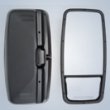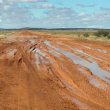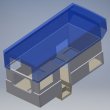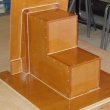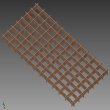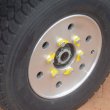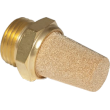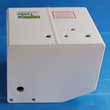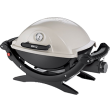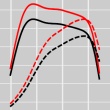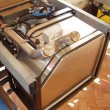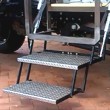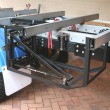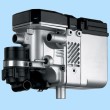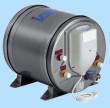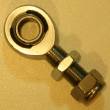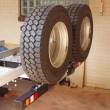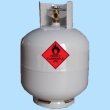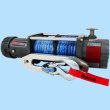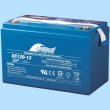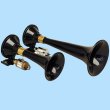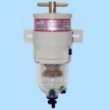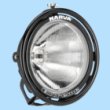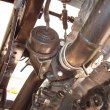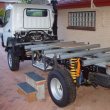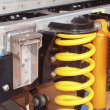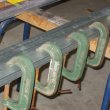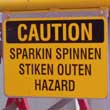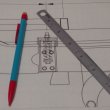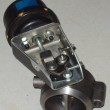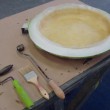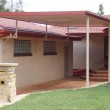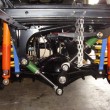Ever since I got my truck I have never really liked the factory mirrors that it came with. In the USA the equivalent Fuso model to mine, the FG140, comes with split mirrors as standard equipment (flat mirror on top and a convex spotter mirror at the bottom), but here in Australia the only option we get is a single, slightly convex mirror, which is a real pain, especially at night when trying to judge distances.

Hopefully some of this information will be of interest to others...
Radiator Splash Guard
The radiator on my Canter is located about 600mm behind the front grille, so airflow is somewhat restricted with this type of setup. To allow the radiator to work at peak efficiency, it must be kept clean. In a vehicle that spends the majority of its life on the tarmac, keeping the radiator clean may not be a challenge, however, if the vehicle is going to be used off road, as mine will be, then protecting the radiator from damage, mud or debris becomes quite important.
Building a Camper Body – Intro
It’s been a very long time coming, but finally I am at the point in this project when I get to build the camper body.
After the test resin infusion went reasonably well I started work on the actual mould for the floor and step well.
Before getting into the details of the mould building and infusion processes, I should probably outline the type of camper body I intend to build.
Resin Infusion – My First Attempt
Before building the actual moulds for my camper body it seemed logical to make at least one test mould and confirm that what I wanted to achieve was possible with the limited composite skills I currently have. After all… I did my trade as a Fitter & Machinist, not as a Shipwright.
Building a Fibreglass Mould Table
It’s taken a long time to get to this point, but finally I am very close to starting work on building my camper body. However, before I can start the body, there’s a few other things I need to do.
Changing over to Alloy Rims
I have always been concerned about the weight of my steel super single wheels and tyres, but at the time that I bought my truck these were the only wheels available that were legal for a 6 tonne GVM truck.
Differential Breathers
If a hot differential is cooled rapidly, by going through water for example, a low pressure area will be created inside the differential. Oil seals are designed to seal in one direction only, so if the low pressure inside the differential cannot be equalized quickly, water will be drawn past the oil seals and into the differential, which can have serious ramifications.
Re-engineering FUSO’s Engineering
You would fully expect that a company as large as FUSO/Mitsubishi would invest a considerable amount of time, effort and money into the research and development of their components in order to produce high quality, durable vehicles. I would too, but I must admit that since buying my truck I have questioned this on several occasions.
Grey and Black Water Tanks
Unlike all of my other tanks, which are made from stainless steel, the grey and black water tanks are made from plastic; Polyethylene to be precise. Surprisingly, there is not a significant difference in price between custom made stainless steel tanks and custom made plastic tanks, but the 10mm thick plastic tanks are significantly lighter than similarly sized stainless steel tanks.
Slide Out Barbecue – Installation
Over the past year or so I have looked at pretty much every marine barbecue available on the Australian market, and some from overseas too. Most of these barbecues were very nicely made, but I couldn’t justify paying over a thousand dollars for something as simplistic as a little stainless steel barbecue.
Water – Fresh and Drinking
I have not completely finished this system as yet but the tanks, pumps and the majority of the plumbing have all been installed. The plumbing and pumps were done a long time ago, but the tanks only went in recently.
Diesel Performance Chip
Well, after much deliberation and research I finally decided to take the plunge and get a diesel performance chip for my truck. There are a multitude of different performance chips available on the market, so the first challenge was deciding which chip technology to use.
Fixing a Major Stuff Up
When building things you always try to do it right the first time, however, when designing something like a one off custom camper, it is inevitable that not everything goes the way you may have planned it, despite your best efforts.
Read more…
A Second Fuel Tank
A general “rule of thumb” when four wheel driving in remote areas of Australia is that your vehicle should be able to carry sufficient fuel to travel at least 1000 kilometres. I have already replaced the OEM 115 litre tank with a 200 litre tank, which should give me that sort of range, but I wanted the ability to carry more fuel, just in case…
Camper Entry Steps
If I could have found some commercial steps that were suitable for my setup I probably would have used those. Alas, nothing on the market looked like it would work for me, so I was forced to make my own camper entry steps.
Slide Out Barbecue Frame
Cooking inside our camper is something we plan to do only when we have to. Our preference is to cook outside whenever possible, therefore there is a requirement for an external barbecue and/or hotplate.
Wiring up a Webasto Thermo Top C
Webasto furnaces were originally designed to pre-heat the vehicle’s engine for optimal starting temperatures in the harsh northern hemisphere winters. Everything that is supplied in the kit is designed for this purpose, including the wiring harness, which is overly complicated for use in a camper’s hydronic heating system.
Heating – Water & Camper
When it comes to heating there are many options to choose from.
For my water heating I decided on using a calorifier (heat exchanger) and for cabin heating I will use reticulated coolant and a radiator/blower setup. A heated towel rail will also be included in the bathroom.
Centrally mounted fuel tank – Revisited
Right from the beginning of this project I made the decision to mount my primary fuel tank between the chassis rails and to do away with the OEM fuel tank that was mounted on the side of the chassis rail. Well… I thought this was technically a good idea, as it moves more of the weight into the centre, but the implementation has proven to be quite challenging.
Rear bar and tyre carrier
I have two spare wheels that need to be mounted on the rear of my truck. These wheels are not light, weighing in at around 80Kg each, so a fairly robust setup is required if the wheel carriers are to withstand the rigours of off road travel. Given the weight of the wheels, a lifting and lowering system will also be required.
Fitting the LPG bottles
Quite a few expedition campers are equipped with diesel powered cooktops, which I did consider, but given that we have no real intention of traveling outside of Australia with our truck, using LPG for cooking seemed like the logical choice for us.
Buying and installing a winch
My intent was always to have a winch fitted to the truck, so when I ordered the bullbar, naturally I specified one that was winch capable.
Unfortunately, the majority of 4WD outlets normally only supply winches up to 12,000lbs, which are not really suitable for a 6 tonne truck.
I needed something bigger!
A home for the house batteries
When designing the camper’s subframe, 730mm was the absolute maximum width that I could make the battery bays. Luckily, this is just wide enough to hold four AGM Deep Cycle house batteries, which is what I intend to use.
Loud is good… right?
If my truck could speak I am sure it would tell me that it was embarrassed by the horn fitted by those people at Fuso.
This is a truck and, in my opinion, it should sound like one when you sound the horn.
A new fuel tank setup
Right from the onset I knew that the Fuso’s OEM diesel fuel tank would not meet my requirements and would need upgrading.
The general “rule of thumb” for four wheel driving in Australia is that you should have enough fuel to do a minimum of 1000 kilometres.
Locking the cab tilt lever
Given the price of truck parts, I am uncomfortable with the thought that Fuso does not provide any way to fully secure the truck.
Much to my amazement, there is no ability to lock the cab tilt lever to stop someone from accessing the engine. To me that’s just bizarre.
Read more…
Improving the cab’s insulation
The 2010 Canter’s cab, in its standard factory configuration, has virtually no insulation from heat or noise.
Having said that, the noise level in the cab is not really that bad, but I wouldn’t complain if it were a little quieter. Thermal insulation on the other hand… that is virtually non existent and can definitely be improved upon.
Read more…
Installing Driving Lights
Installing a set of driving lights is probably the most common upgrade task carried out by anyone wanting more visibility on the road than is provided by the standard headlights.
If you have any electrical know how the installation should be pretty straight forward, but if you don’t, it can be a bit of a challenge.
Cab tilt warning system
As with most cab over trucks fitted with a bullbar, it is necessary to tilt the bullbar prior to tilting the cab. Failing to tilt the bullbar first will likely result in damage to the cab. I have first hand knowledge of this… I forgot and ended up with a $300 repair bill.
Read more…
More brackets and a new exhaust
The past few weeks have been spent building a multitude of brackets, or modifying existing ones.
Brackets for the new fuel tank and for the calorifier needed to be in place in order to position the exhaust hanger brackets correctly.
Read more…
First milestone reached
It has taken considerably longer than I would have liked but I have now reached my first milestone, that being to get the truck to a stage where it can be registered.
Unlike other states in Australia, in the ACT it is not possible to register a cab chassis truck; the vehicle must have a “function”, according to our Road Transport Authority (RTA).
Building a subframe system – Part 3
With most of the involved work done for the subframe it was now down to finishing everything off.
The first task was to complete the welding of the subframe then design and build the entry area for the camper body and finally, construct the frame to carry the truck battery box.
Building a subframe system – Part 2
Prior to getting back to working on the subframe there was a need to address another issue… how was I going to get the completed subframe on and off the truck by myself?
While working on the individual rear rails it was not too difficult carrying and fitting these onto the chassis but the moment I joined the left and right rails this would no longer be a one person lift.
Building a subframe system – Part 1
Finally, after much waiting, I have received everything that I needed to start work on my subframe system.
I thought that this part of the build would be fairly straight forward but, as is often the case, it doesn’t always work out exactly that way.
How to make a Fitter happy
One of the major drawbacks about being a Fitter is that should you want to set yourself up with a decent machine shop you need a lot of money and quite a bit of space. Sure, you can get those cheap (normally Chinese) machines, but in my experience, most of those aren’t that good. It’s a choice… toys or real tools, and do you have the space?
Designing a spring mounted subframe system
Designing a suitable subframe system is paramount to having a successful platform to house a camper body. My intent is also to hang the batteries and water tanks from the subframe, along with some other stuff, so my subframe needs enough strength to do that too.
Read more…
Getting advice from an engineer
Building your own motorhome is no small project and making the right decisions at the right time during the build process can save a lot of pain and ultimately, money.
To that end, getting to know the engineer you will be using, and you will need an engineer, can be very beneficial.
An Isuzu exhaust brake on a Fuso
With the planned layout of fuel and water tanks it would be necessary to re-route the standard exhaust system. Given that I would need to replace the majority of the exhaust I decided that I may as well go all out and change the standard 21/4” system to a 3″ system. Doing this should have the added benefit of more power due to better gas flow.
Fibreglass composites course
A home for our truck
Unfortunately, given the height of the truck’s cab, it was not possible to park the vehicle in my garage. I did not really want to leave it exposed to the elements, nor did I want to park it on the street, so I started looking at possible options.
Read more…
Core modifications to the Canter
Anyone that has taken a ride in a standard Canter truck will know that it is not really an enjoyable experience; the suspension is very hard and the factory shock absorbers do virtually nothing.
Read more…
The search for a 4×4 motorhome
My criteria was quite simple; I wanted a vehicle that could go pretty much anywhere, within reason, and that was capable of free camping for an extended period of time.
For over 18 months I scoured the Internet in search of a good second hand 4×4 motorhome.
So, what is an expedition camper?
An expedition camper is a recreational vehicle, commonly referred to as a motorhome or RV, designed for extended travel and capable of going to very remote locations.
There are some half decent motorhomes on the market, like those made by Winebago, but expedition campers are designed to go where the average motorhome can’t, or should never go; Read more…
